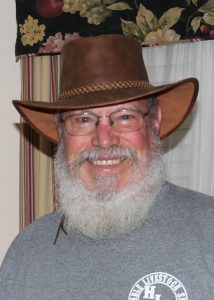 Robert Comstock’s love of the outdoors started at an early age. Growing up in the San Franciso Bay Area he spent many summer vacations in the California State Parks with his family. The space program brought Roberts family to Houston in the early 1960’s, which he has called home ever since. Robert graduated from Stephen F. Austin State University with degrees in Forestry and Sociology. He started his long career with Texas Parks & Wildlife in 1977 as a Park Ranger at Galveston Island SP. In 1984 The parks division took over management of the then Sheldon Wildlife Management Area and Robert transferred over as the Park Superintendent. He spent the next 28 years at Sheldon and was instrumental in the development of the park and the Sheldon Lake Environmental Learning Center. Robert is retired from TPW and now spends his time volunteering in the community. He can be seen participating in bird walk in area parks on any given Saturday throughout the year. He lives in Humble TX with his wife Paula and numerous cats.
Robert Comstock’s love of the outdoors started at an early age. Growing up in the San Franciso Bay Area he spent many summer vacations in the California State Parks with his family. The space program brought Roberts family to Houston in the early 1960’s, which he has called home ever since. Robert graduated from Stephen F. Austin State University with degrees in Forestry and Sociology. He started his long career with Texas Parks & Wildlife in 1977 as a Park Ranger at Galveston Island SP. In 1984 The parks division took over management of the then Sheldon Wildlife Management Area and Robert transferred over as the Park Superintendent. He spent the next 28 years at Sheldon and was instrumental in the development of the park and the Sheldon Lake Environmental Learning Center. Robert is retired from TPW and now spends his time volunteering in the community. He can be seen participating in bird walk in area parks on any given Saturday throughout the year. He lives in Humble TX with his wife Paula and numerous cats.

Rob Comstock
Upcoming Events
In northeast Harris County, Lake Houston dams the confluence of the two forks of the San Jacinto River, Luce Bayou and Cypress Creek. The mighty San Jac watershed bottomlands hold a bounty of flora and fauna along its courses. Beaver and river otter share Lake Houston with alligator and banded water snakes to name a few. Overhead gulls, pelican and waterbirds move in groups plying the water of the lake for fish. In the spring, the dawn song from the forest is large and loud. Target local nesters include Brown-headed Nuthatch, Red- headed Woodpecker, Bald Eagle, Anhinga and Pine Warbler. Neotropic nesters we hope to encounter: Prothonotary Warbler, Swainson’s Warbler, Painted Bunting, Hooded Warbler, Purple Gallinule and Yellow-billed cuckoo. This habitat also serves the avian migration north, with respite for Blue Grosbeak, Black-throated Green Warbler, Swainson’s Hawk, Western Sandpiper and many others.
Find out more »Boy Scout Woods, Smith Oaks, The Rookery, and more! From under an ancient sea, a salt dome emerged. After a few thousand years the dome reached 38-feet above a pancake-flat coastal plain; the highest point-of-land on the immediate coast from Mobile Bay to the Yucatan Peninsula. This is High Island, which is now a wooded beacon amongst the coastal marshland providing food, water, and places to rest for weary Gulf migrants. The daily afternoon arrival of neotropic migrants often includes…
Find out more »Galveston’s West End has drawn birders from all over the world for nearly 100 years. In addition to estuarial saltwater marsh, it contains freshwater ponds, pockets of scrubland, mudflats, and sandy beach habitat. This combination attracts a wide variety of shorebirds, waterfowl, raptors, songbirds, and more. We will begin the trip by viewing tidal pools on the Gulf of Mexico side and work our way to the estuaries on the edge of West Bay, stopping at freshwater ponds along the…
Find out more »The spectacle of a water bird nesting rookery is a birder “must see.” North Deer Island has 1.7 miles of protected shoreline which supports nesting habitat for the threatened Reddish Egret and 16 other bird species. Rookeries dot the Texas Gulf coast. Among the best in Texas is 144-acre North Deer Island shared by nesting herons, egrets, ibis, cormorants, shorebirds and seabirds. You’ll witness the sight, sounds and smells of thousands of Brown Pelican (approximately 40% of TX coastal nesters),…
Find out more »Brazos Bend can be the perfect ending to your FeatherFest experience! Drive your own car to beautiful Brazos Bend State Park and meet with local guides, Mark Scheuerman and Kristine Rivers. Note: Drive time to Brazos Bend is about 1 ½ hours from FeatherFest Headquarters. The park opens at 8:00 am This beautiful state park is 4,897 acres along the Brazos River in Needville, Texas, and has land in the Brazos River Floodplain with magnificent moss-covered and vine-draped live oak woodlands. The…
Find out more »